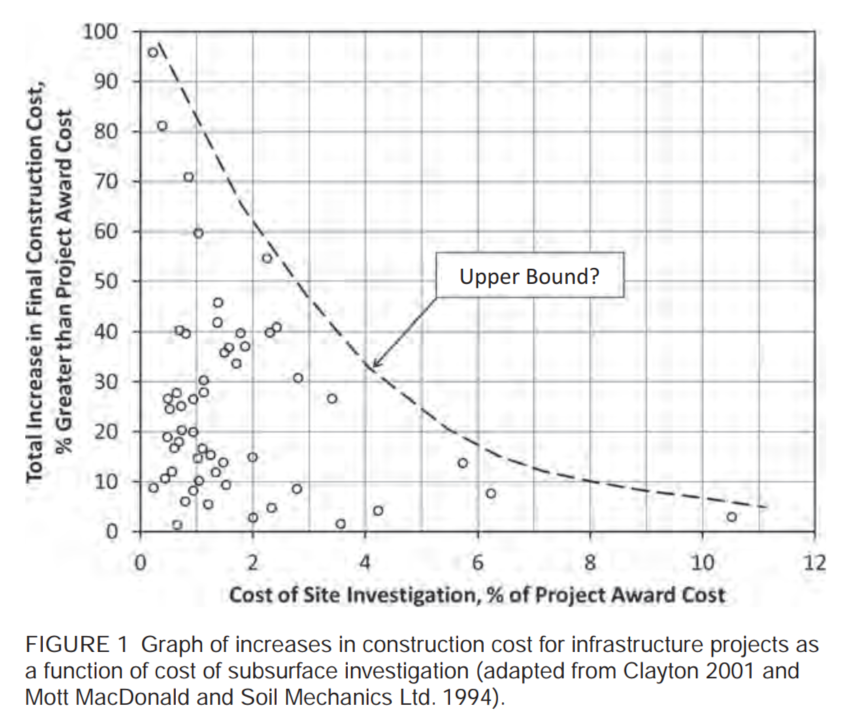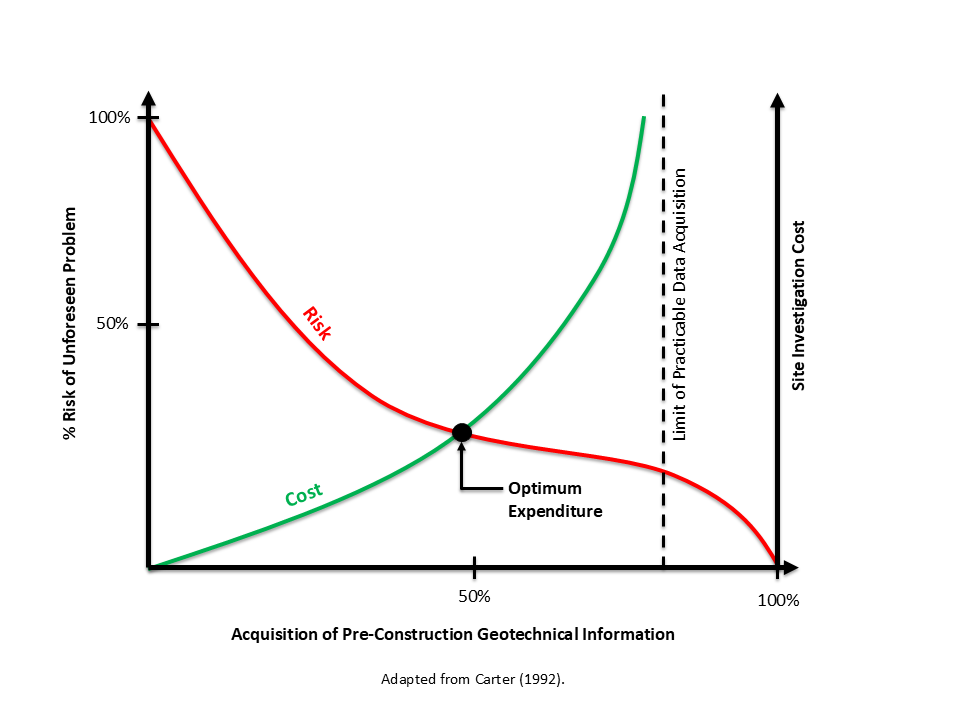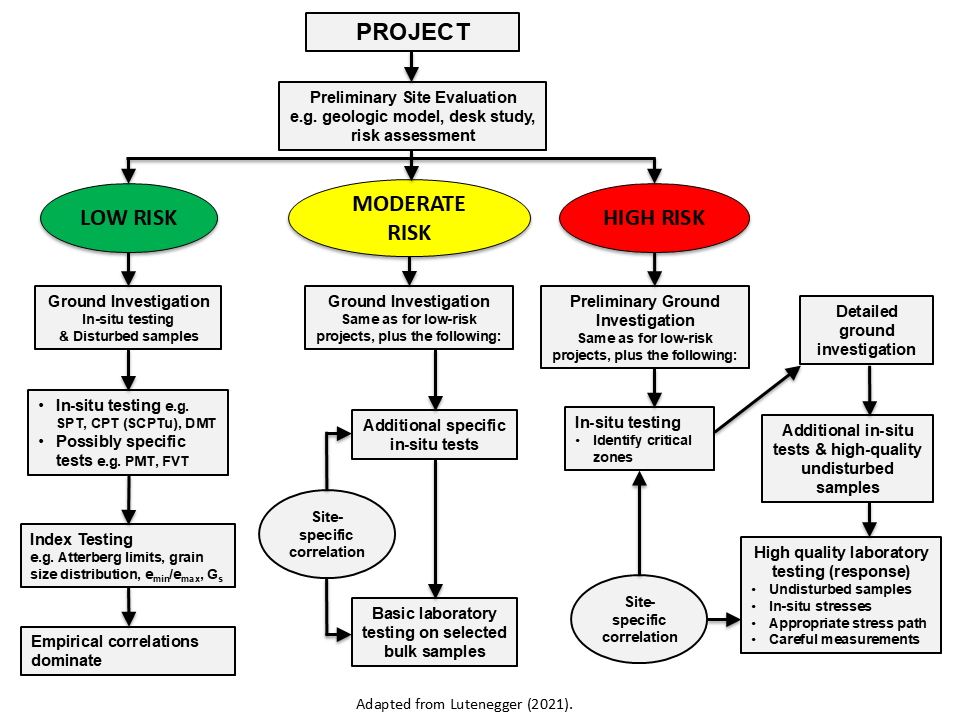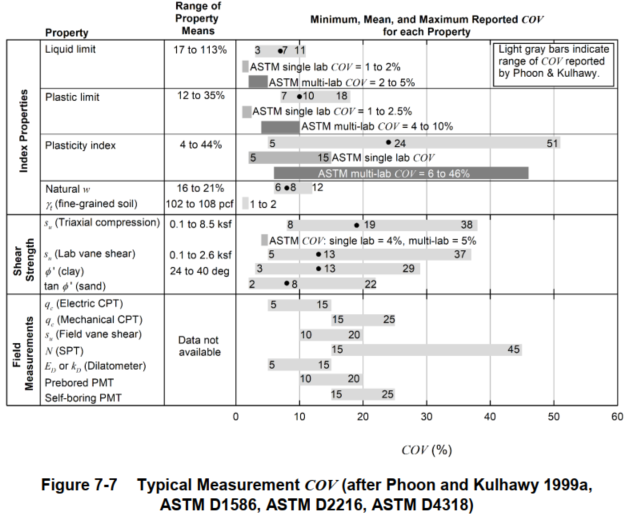Ground Truths - Geotechnical Risks and Costs
Introduction
In the world of infrastructure development, what lies beneath the surface is usually the greatest unknown. While towering structures and expansive roadways may command attention, the ground they rest upon silently holds the power to compromise timelines, budgets, and safety. Geotechnical risks have been responsible for some of the costliest overruns in construction history. Geotechnical risk can be defined as a combination of uncertainty in ground conditions and the potential consequences of that uncertainty.
Yet, every risk is tied to a cost, both in its mitigation and in its realization. How much should we spend to know more about the subsurface? At what point does additional investigation no longer yield meaningful risk reduction? And how should we balance sophisticated design approaches with practical realities of uncertain ground?
This article explores the delicate interplay between site investigation and the economics of risk in geotechnical engineering. Drawing from some of InnovoGeo’s favorite resources, we aim to clarify how high-value geotechnical decisions are made in pursuit of informed, cost-effective action. The references discussed will help provide a background on the unique relationships between risk and cost in geotechnical engineering, based on many decades of past project experience, and provide lessons learned that can be applied to future projects.
Whitman (1984) explores the role of judgment and uncertainty in geotechnical risk evaluation. He emphasizes that while mathematical tools like probability and reliability analysis are useful, they are subordinate to engineering judgment, especially in complex ground conditions. The paper provides the following key points:
Risk ≠ Probability Alone: Whitman argues that risk evaluation in geotechnics must consider consequences, not just likelihood.
Site Investigation as Decision-Making Tool: He frames site investigations as exercises in decision-making under uncertainty, not just data collection.
Value of Simple Tools: Whitman favors simple calculations supplemented by judgment over complicated probabilistic methods that may mask underlying uncertainties.
Whitman explains that the goal of site investigation is not to eliminate risk, but to make it acceptable and manageable, and justifies why we aim for "optimum" site investigation, not exhaustive.
Quotes:
Almost every factor with which we deal in engineering analysis is truly a random variable, although the values of some are much less uncertain than those of others. With a proper appreciation of uncertainty, we can, of course, do good engineering without explicitly taking this randomness into account. Probability theory helps us, as engineers, to evaluate the relative importance of various uncertainties and to decide upon appropriate levels of conservatism.
Probability theory - when properly used - can be a powerful tool for achieving a good balance between the consequences of uncertain knowledge and the cost of reducing that uncertainty.
NCHRP Synthesis 484 (National Academies, 2016) underscores that inadequate geotechnical investigation is a leading contributor to construction claims, change orders, and cost overruns in transportation projects. Drawing from DOT surveys and case studies, it identifies that subsurface conditions often emerge as the most unpredictable and under-investigated aspect of preconstruction planning. Key geotechnical issues include insufficient boring density, lack of geophysical data, over-reliance on outdated or interpolated soil information, and misalignment between design needs and investigation scope. The report ties the quality and scope of geotechnical investigations directly to project risk, highlighting that uncertainty in subsurface conditions carries disproportionate cost consequences when not adequately managed. The report ultimately recommends risk-based approaches to geotechnical scope development, early multidisciplinary involvement, and better communication between geotechnical engineers and design teams to mitigate downstream impacts. This relationship is clearly illustrated below in Figure 1 from the report, which shows the decreasing trend in project cost overruns with increased cost of site investigation. Hlepas and Bateman (2021) provides an update of this figure, to include data from several US Army Corps of Engineers projects.
Carter (1992) dives deeper into sources of uncertainty in geotechnical predictions and emphasizes why engineering geology must adopt probabilistic thinking, especially when dealing with variable ground conditions and imperfect data. He explores three types of Uncertainty: inherent variability (natural spatial variability in soil and rock), model uncertainty (simplifications and assumptions in analysis models), and measurement uncertainty (errors in field/lab testing).
Quotes:
Prediction of geology for underground situations (eg. ahead of a tunnel excavation) is one area where uncertainty will likely always remain, as, even with significant site investigation expenditure it will never be practical to achieve 100% predictive accuracy.
Risk can be minimized by increasing expenditure on site investigation, but prediction requires judgment and experience in addition to the raw data acquired by investigation techniques.
Risk minimization by blanket use of conservative design solutions can lead to gross increases in overall project costs.
Design optimization within the constraints of good geological predictive information provides not only the most cost-effective approach for a given project, it also provides the best insurance against "unforseen ground condition" claims.
From Carter’s paper, we can understand that "perfect knowledge" is impossible in geotechnical engineering, even with an infinite cost spent on investigation and design. However, a point of “optimum expenditure” exists in theory, where investigation costs are best balanced with reduction in risk. This paper helps explain why geological prediction inherently involves probabilistic reasoning, and why designs must accommodate this uncertainty rather than pretend it doesn't exist.
Briaud (2013) discusses the amount of soil testing necessary to meet a reliability target. The figure below (from this video) is for a block of soil to be loaded by a structure, having a cube shape of 10 x 10 x 10 m in size. For the example, the following targets and assumptions are made: predicting settlement of the structure with a precision of ±20% with a 98% degree of confidence, and assuming the coefficient of variation (COV) of the modulus of 0.3. Based on these, current practice might perform 5 borings, while 40 borings would be required to test an adequate volume of soil to achieve the desired reliability target.
Failmezger (2020) emphasizes that uncertainty in geotechnical design stems not only from natural subsurface variability but also from the accuracy of in‑situ testing and predictive models - arguing that choosing test methods that are poor predictors inflates perceived variability, drives overly conservative designs, and ultimately leads to “financial failure” (i.e., unnecessarily high foundation costs). He advocates using beta probability distributions to quantify performance uncertainty and recommends selecting the most accurate test and design method to minimize standard deviation and align construction cost with true performance needs. The Probability of Success (PoS) is defined in the paper as the area under the chosen beta probability distribution curve that lies within acceptable performance limits. That is, the portion of the curve outside the defined failure zone (e.g., factor of safety ≥ 1.0 or settlement below maximum threshold).
Lutenegger (2021) highlights that traditional field testing methods—such as the Standard Penetration Test (SPT)—often carry higher uncertainty and can lead to more conservative and costly foundation designs, especially when compared to more precise techniques like Cone Penetration Testing (CPT). It argues for a risk-informed selection of field testing tools, stressing that deploying newer, data-rich techniques strategically can yield better design confidence and reduced overall project risk without inflating costs. The article also underscores the importance of effectively communicating investigation needs and risk profiles to stakeholders to ensure budget alignment and decision-making efficiency. Selecting appropriate field testing methods - not simply performing more tests - is a critical approach to reducing geotechnical risk. The article also discusses the ten “deficiencies” raised by Professor Jorj Osterberg - which the reader is encouraged to review.
The flowchart below, adapted from Lutenegger’s article, outlines a structured approach to geotechnical site investigation based on project risk classification - low, moderate, or high. Each risk level triggers a progressively more rigorous investigation strategy: from basic in-situ and index testing under low-risk scenarios, to detailed, stress-path-dependent laboratory testing and undisturbed sampling in high-risk cases. This visual decision tree underscores a core principle echoed by referenced discussed earlier: geotechnical engineering is not about eliminating uncertainty, but managing it appropriately. Carter’s argument for “optimum expenditure” finds a practical extension here - investigation effort is scaled not to exhaust knowledge, but to match the consequences of getting it wrong. The figure reinforces that risk-informed investigation is the cornerstone of cost-effective and responsible geotechnical design.
The recent update to NAVFAC DM-7.02 (U.S. Army Corps of Engineers, 2025) provides the following two figures that illustrate the variability inherent in soil and rock properties and measurement error. These figures show that even the most basic geotechnical index properties can have considerable inherent variability, and that lower variability in measurement error can be achieved by collecting high-quality subsurface information using methods like cone penetration testing (CPT) compared to conventional methods like standard penetration testing (SPT).
Conclusion
We can see that the flowchart adapted from Lutenegger’s article begins with a Preliminary Site Evaluation phase for all projects, before a risk category can be assigned. InnovoGeo’s InnovoIntel reports have been developed for this reason. Before proceeding to develop a scope for a geotechnical investigation, understanding project risks is a critical step that is often overlooked. We can also understand how selecting a geotechnical consultant based on a low-bid approach often leads to under- or improperly-scoped investigations, increased uncertainty, and higher project costs. This impacts both owner and client value, and ultimately, project success.
The references discussed in this article provide a framework to make smarter and better-informed decisions in the future. Following are some key observations we can take away:
Differentiation is needed between risk of unforeseen problems and risk of failure.
Risks carry both direct and indirect costs through the performance life of the structure or facility.
Different types of uncertainties exist: inherent and measurement variability, model uncertainty, and data limitations.
Geotechnical engineering is fundamentally an exercise in managing uncertainty, but that uncertainty can never be completely eliminated.
Decisions must be grounded in both good and sufficient data and good engineering judgment.
The cost of knowing more must always be weighed against the cost of not knowing enough.
References
Briaud, J. L. (2013). Ménard lecture: The pressuremeter test: Expanding its use. In Proceedings of the 18th International Conference on Soil Mechanics and Geotechnical Engineering, Paris, France (pp. 107-126).
Carter, T. G. (1992). Prediction and uncertainties in geological engineering and rock mass characterization assessments. In Proceedings of the 4th Italian Rock Mechanics Conference.
Failmezger, R.A. (2020). Financial Failure—The High Cost of Not Knowing. Proceedings of the 6th International Conference on Geotechnical and Geophysical Site Characterization. http://www.isc6.org/images/Cikkek/Sessions/ISC2020-252.pdf
Hlepas, G. and Bateman, V.C. (2021). Pay Now, or Pay Later; Using a Risk-Informed Mindset for Site Investigation Decisions. GeoStrata Magazine Archive, 25(1), 60-65. https://www.readgeo.com/geostrata/january_february_2021/MobilePagedArticle.action?articleId=1651743#articleId1651743
Lutenegger, A. J. (2021). Practical Aspects of Routine Geotechnical Site Investigations. GeoStrata Magazine Archive, 25(1), 54-59. https://www.readgeo.com/geostrata/january_february_2021/MobilePagedArticle.action?articleId=1651742#articleId1651742
National Academies of Sciences, Engineering, and Medicine. (2016). Influence of Geotechnical Investigation and Subsurface Conditions on Claims, Change Orders, and Overruns. NCHRP Synthesis 484. https://nap.nationalacademies.org/catalog/21926/influence-of-geotechnical-investigation-and-subsurface-conditions-on-claims-change-orders-and-overruns
U.S. Army Corps of Engineers, Naval Facilities Engineering Systems Command (2025). Foundations and Earth Structures (DM 7.2), UFC 3-220-20. https://www.wbdg.org/FFC/DOD/UFC/ufc_3_220_20_2025.pdf
Whitman, R. V. (1984). Evaluating calculated risk in geotechnical engineering. Journal of Geotechnical Engineering, 110(2), 143-188.





